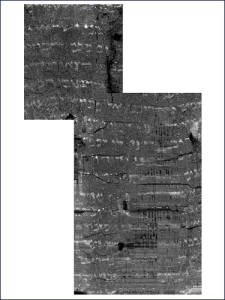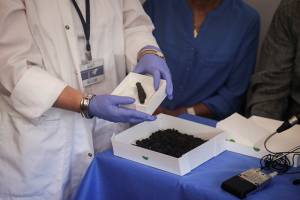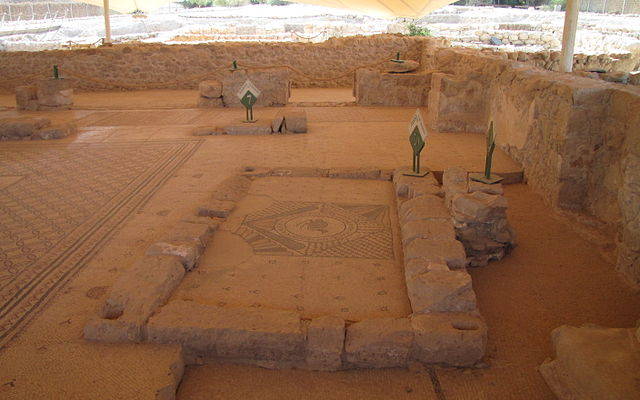Scientists used advanced technology to unravel a decades-old mystery, managing to unlock an amazing archaeological treasure discovered in the ancient synagogue of Ein Gedi.
For decades, parts of a scroll that was completely burnt some 1,500 years ago, found inside the Holy Ark of the ancient synagogue at Ein Gedi, near the Dead Sea, were illegible, leaving the contents of the remnant shrouded in mystery.
Thanks to modern technology, researchers were now able to decipher the scroll’s contents, revealing it to be one of the most ancient Torah scrolls known to mankind.
At the end of extremely challenging efforts, which lasted over a year, the scientists and researchers were amazed to decipher verses from the beginning of the Book of Leviticus, written in Hebrew.
The rare find was presented on Monday at a press conference in Jerusalem, attended by Minister of Culture and Sports Miri Regev and Israel Antiquities Authority (IAA) Director Israel Hasson.
The parchment scroll was unearthed in 1970 in archaeological excavations in the synagogue at Ein Gedi in southern Israel, headed by the late Dr. Dan Barag and Dr. Sefi Porath. However, due to its charred condition, it was not possible to preserve or decipher it.

Scroll fragment as imaged in The Lunder Family Dead Sea Scrolls Conservation Center. (IAA/Shai Halevi )
The Lunder Family Dead Sea Scrolls Conservation Center of the Israel Antiquities Authority, which uses state of the art, advanced technologies to preserve and document the Dead Sea Scrolls, enabled the decoding of this important find. Carbon dating analysis puts it in the late sixth century.
To date, this is the most ancient scroll from the five books of the Hebrew Bible to be found since the Dead Sea Scrolls.
The IAA has been cooperating with scientists from Israel and abroad to preserve and digitize the Dead Sea Scrolls.
About a year ago Merkel Technologies Company in Israel offered professional assistance in performing high-resolution 3D scanning of some Dead Sea Scrolls fragments and tefillin (phylacteries) cases by means of a Micro-CT scanner.
The IAA sent the scan results to Professor Brent Seales of the University of Kentucky, who developed a digital imaging program that allows the text to be virtually unrolled and visualized.
The researchers experienced great surprise and excitement when the first eight verses of the Book of Leviticus suddenly became legible.
This is the first time in any archaeological excavation that a Torah scroll was found in a synagogue, particularly inside a Holy Ark.
An Exciting and Meaningful Discovery
Decades after finding the scrolls, Dr. Sefi Porath said that “the deciphering of the scroll, which was a puzzle for us for 45 years, is very exciting.”
Ein Gedi was a Jewish village in the Byzantine period (4th-7th century CE) that had a synagogue with an exquisite mosaic floor and a Holy Ark. The settlement was completely burned to the ground, and none of its inhabitants ever returned to reside there or to pick through the ruins to salvage valuable property.

IAA representatives show charred remains of a 1,500-year-old scroll. (Flash90)
In the archaeological excavations of the burnt synagogue, Porath found, in addition to the charred scroll fragments, a bronze, seven-branched candelabrum (menorah), the community’s money box containing some 3,500 coins, glass and ceramic oil lamps and vessels that held perfume.
“We have no information regarding the cause of the fire, but speculation about the destruction ranges from Bedouin raiders from the region east of the Dead Sea to conflicts with the Byzantine government,” Porath explained.
Pnina Shor, curator and director of IAA’s Dead Sea Scrolls Projects, viewed dealing with the Dead Sea Scrolls on a daily basis as a “real privilege.”
“The knowledge that we are preserving the most important find of the 20th century and one of the Western world’s most important cultural treasures causes us to proceed with the utmost care and caution and use the most advanced technologies available today,” she stated.
“This discovery absolutely astonished us: we were certain it was just a shot in the dark but decided to try and scan the burnt scroll anyway. Now, not only can we bequeath the Dead Sea Scrolls to future generations, but also a part of the Bible from a Holy Ark of a 1,500-year old synagogue!”
By: United with Israel Staff

Free Ebook: 10 Best Places to Visit in Israel
The Land of Israel has provided the backdrop for some of the most important events in human history. From the Old City in Jerusalem to the Sea of Galilee, people from all over the globe visit the Holy Land each year to take in the breathtaking scenery and inspiration of Israel. Now you can experience this beauty for yourself from the comforts of home and maybe plan a trip of your own to Israel. Get the free, exclusive eBook from United with Israel: The 10 Best Places to Visit in Israel.
